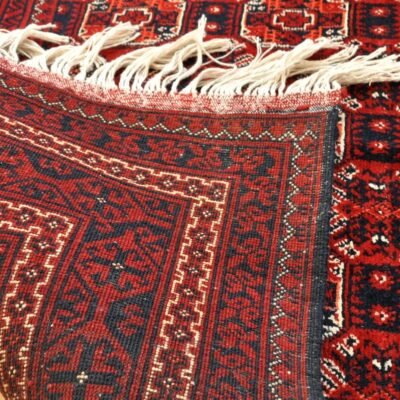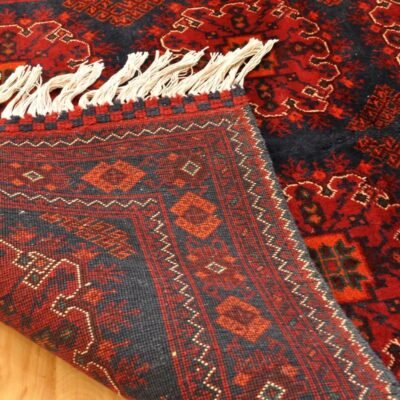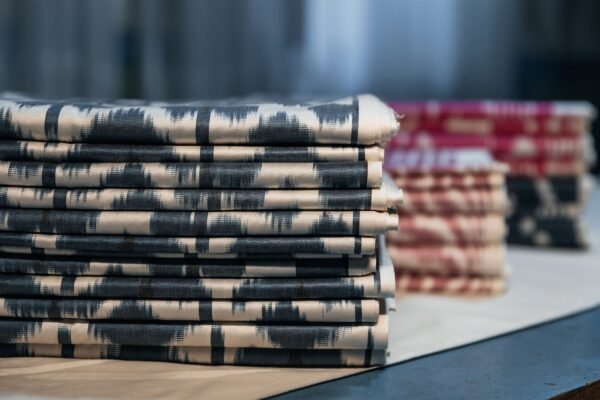Cultural Significance of Turkmen Rugs
Turkmen rugs hold significant cultural and artistic value, reflecting the social and cultural life of the Turkmen people. Traditional Turkmen carpet making art has been inscribed on the Representative List of the Intangible Cultural Heritage of Humanity by UNESCO, highlighting its importance in the global cultural landscape. The carpet-making art is broadly integrated into the social and cultural life of Turkmen people and is considered a sign of cultural identity and unity. Related skills and knowledge are transmitted within the family, and the viability of the tradition has been continuously ensured by community members. The annual celebration of Carpet Day plays a key role in the transmission of the element by gathering various participants.
Famous Weavers
Turkmen rugs are primarily produced by the Tekke tribe, who were once the most powerful and influential tribe in the region. These rugs are renowned for their high knot count and unique designs. Other Turkmen tribes, such as the Yomut, Salor, and Ersari, also produce rugs with their distinct designs and motifs. The Turkmen Carpet Museum in Ashgabat, Turkmenistan, showcases a vast collection of Turkmen rugs, including those made by famous weavers.
Regions Known for Their Rug Production
Turkmen rugs are handmade in northwestern Iran, parts of Turkey, Turkmenistan, Azerbaijan, Uzbekistan, Syria, and parts of the former Soviet Union. The city of Ashgabat in Turkmenistan is known for its high-quality rugs, with the Tekke tribe being the primary producers. The Ersari tribe, located in the Amu Darya River basin, is known for producing rugs with octagonal elephant's foot designs. The Yomut tribe, located in the Caspian Sea region, produces rugs with Bokhara designs. The Salor tribe, located in the Merv Oasis, produces rugs with unique designs and motifs.
Turkmen Rug Production
Crafting a Turkmen rug is an intricate process that involves various steps and techniques. These rugs are created on horizontal or vertical looms, mainly using different colored wool threads. The dense texture of the carpets is ornamented with characteristic colored patterns, often representing one of the five main Turkmen tribes. The context in which the carpet weaver lives, including the local flora, fauna, and environment, is reflected in the combination of threads, pictures, and colors, creating the unique designs of Turkmen rugs.
The Process of Making Turkmen Rugs
To add depth and specific details regarding the techniques used in Turkmen rug production, it is important to note that crafting a Turkmen rug is an intricate process that involves various steps and techniques. These rugs are created on horizontal or vertical looms, mainly using different colored wool threads. The dense texture of the carpets is ornamented with characteristic colored patterns, often representing one of the five main Turkmen tribes. The context in which the carpet weaver lives, including the local flora, fauna, and environment, is reflected in the combination of threads, pictures, and colors, creating the unique designs of Turkmen rugs.
The process of making a Turkmen rug involves several stages, including spinning, dyeing, and weaving. The wool is first spun into yarn, which is then dyed using natural dyes made from plants and insects. The dyed yarn is then woven into the rug using a variety of techniques, including the Ghiordes knot and the Senneh knot. The Ghiordes knot is a symmetrical knot that is commonly used in Turkish and Turkmen rugs, while the Senneh knot is an asymmetrical knot that is commonly used in Persian rugs.
Turkmen Rug Patterns and Symbols
Turkmen rugs are known for their clear linear geometric arrangements and symbolic motifs. The patterns and symbols used in these rugs hold significant cultural and historical meaning, representing the Turkmen people's identity and unity. The colors and patterns in Turkmen rug design also have specific significance, reflecting the weaver's inspiration from the surrounding environment and cultural influences.
The designs and motifs used in Turkmen rugs are often symbolic and hold significant cultural and historical meaning. The colors and patterns in Turkmen rug design also have specific significance, reflecting the weaver's inspiration from the surrounding environment and cultural influences. For example, the Tekke tribe's rugs often feature the Tekke gul, a design that represents the tribe's identity and unity. The Ersari tribe's rugs often feature octagonal elephant's foot designs, which are believed to represent the elephant's footprints left behind by Alexander the Great's army.
Collecting Turkmen Rugs
For collectors interested in acquiring Turkmen rugs, it is essential to differentiate between authentic and replica pieces. Authentic Turkmen rugs are handcrafted by skilled artisans using traditional techniques and materials. These rugs often have unique designs and can be more valuable than mass-produced replicas. When purchasing a Turkmen rug, consider its origin, design, and the reputation of the seller to ensure its authenticity and quality.
The Value of Turkmen Rugs
Turkmen rugs have not only cultural and artistic value but also market value and investment potential. These rugs are exported to more than 50 countries, and their unique designs and durability make them sought after by collectors and enthusiasts. Famous Turkmen rug collections, such as those made by the Tekke, Yomut, Salor, and Ersari Turkmens, have gained recognition for their quality and craftsmanship. Investing in authentic Turkmen rugs can be a way to appreciate their cultural significance while potentially gaining value over time.
How to Differentiate Between Authentic Turkmen Rugs and Replicas
Turkmen rugs are handmade floor-covering textiles that are highly valued for their unique designs and durability. However, with the rise of mass-produced imitations, it has become increasingly challenging to distinguish between authentic and fake Turkmen rugs. Here are some tips for buyers to help differentiate between authentic Turkmen rugs and replicas:
- Look for hand-knotted rugs: Authentic Turkmen rugs are hand-knotted, which means that each knot is tied by hand. Machine-made rugs are often cheaper and less durable than hand-knotted rugs.
- Check the materials: Authentic Turkmen rugs are made from high-quality materials such as wool, cotton, and silk. Synthetic materials are often used in fake rugs and produce colors that are brighter and more uniform in appearance.
- Examine the design: Authentic Turkmen rugs have unique designs and motifs that reflect the social and cultural life of the Turkmen people. Replicas often have generic designs that lack the intricate details and symbolism of authentic rugs.
- Check the back of the rug: Authentic Turkmen rugs have a soft backing made of wool or cotton, while replicas often have a hard plastic backing.
- Consider the price: Authentic Turkmen rugs are often more expensive than replicas due to the high-quality materials and intricate craftsmanship involved in their production. If the price seems too good to be true, it may be a sign that the rug is a replica.
Where to Buy
Turkmen rugs can be purchased from various sources, including online platforms. One such platform is Alesouk, which offers a wide range of handmade rugs, including Afghan rugs. Alesouk provides a convenient shopping experience, allowing customers to browse through their collection, select their favorite pieces, and add them to the shopping cart.
Caring for Turkmen Rugs
Caring for Turkmen rugs is crucial to maintain their beauty and longevity. Here are some guidelines for maintaining the quality of Turkmen rugs:
- Regular vacuuming: Vacuum the rug regularly to prevent dust and dirt from accumulating on the surface. Use a vacuum cleaner with a low suction setting to avoid damaging the rug's fibers.
- Rotate the rug: Rotate the rug every few months to prevent uneven wear and tear. This is especially important for rugs placed in high-traffic areas.
- Avoid direct sunlight: Avoid placing the rug in direct sunlight to prevent fading. If possible, use window shades or curtains to block the sun's rays.
- Clean spills immediately: Clean any spills or stains immediately using a soft cloth and a mild detergent. Avoid using harsh chemicals or bleach, as they can damage the rug's fibers.
- Professional cleaning: If the rug is heavily soiled or stained, consider professional cleaning services specializing in rug care. They can help preserve the rug's quality and appearance.
- Storage: If you need to store the rug, roll it up and wrap it in acid-free paper or a breathable fabric. Avoid storing the rug in damp or humid areas, as this can cause mold and mildew to grow.
Conclusion
Turkmen rugs are more than just floor coverings; they are a reflection of the Turkmen people's rich cultural heritage and artistic expression. Their unique designs, intricate craftsmanship, and symbolic motifs make them a valuable part of the global textile industry. Whether you are a collector, enthusiast, or simply appreciate the beauty of these rugs, exploring the world of Turkmen rugs is a journey that will deepen your understanding of this ancient art form.





